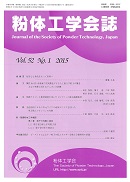巻号一覧

前身誌
52 巻, 8 号
選択された号の論文の5件中1~5を表示しています
- |<
- <
- 1
- >
- >|
論文
-
小野 公徳, 松川 嘉也, 渡辺 愛貴, 出羽 一樹, 齋藤 泰洋, 松下 洋介, 青木 秀之, 江良 康貴, 青木 崇行, 山口 東吾2015 年52 巻8 号 p. 426-434
発行日: 2015/08/10
公開日: 2015/09/08
ジャーナル フリーThis study introduces a new collision detection method obtained by modifying the grid partitioning method, which employs spatial- and cell-partitioning, into an aggregate mean free path-cluster-cluster aggregation (AMP-CCA) model. This modification allows the AMP-CCA model to calculate the three-dimensional aggregate morphology and particle size distributions (PSDs) with computational efficiency. As compared with the previous model, the new model successfully calculates the morphology in 15% of the computational time. The calculated PSDs for a coalesced spherical particle aggregate, as calculated by the AMP-CCA model, are in reasonable agreement with the results of the sectional model regardless of concentration. The morphology calculated by the AMP-CCA model is in good agreement with previous experimental and numerical results. The AMP-CCA model, employing direct Monte Carlo simulation, serves as a useful tool to calculate the aggregate morphology and PSDs with reasonable accuracy.抄録全体を表示PDF形式でダウンロード (1198K) -
忍足 輝男, 木村 将貴, 山本 一己, 福井 国博, 吉田 英人2015 年52 巻8 号 p. 435-444
発行日: 2015/08/10
公開日: 2015/09/08
ジャーナル フリーWe have developed a classifier of cyclone type to eliminate coarse acrylic resin particles of 30μm size and over from the other fine. The classifier is composed of the outside and inside collection boxes, which configure the slit convex upward for separating. When the blow-up air from the outside box flows rotating into the slit, the coarse particles are selectively collected to the outside box by the centrifugal force of the rotating flow, which predominates over the drag force induced by the blow-up.
This paper investigated the influence of the width of the slit and the blow-up flow rate etc. on the performance, which was evaluated with the yields and the partial separation efficiency.
As a result, the classifier was optimized, and the feature was demonstrated in detail. Furthermore, the classifier proved to possess the high capability for separating without extremely decreasing the yield by means of coordinating the blow-up flow rate with the cyclone's main flow.抄録全体を表示PDF形式でダウンロード (1628K) -
山本 通典, 石原 真吾, 加納 純也2015 年52 巻8 号 p. 445-452
発行日: 2015/08/10
公開日: 2015/09/08
ジャーナル フリーThe effect of particle shape on mixing phenomena in a rotating drum was analyzed by experiment and Distinct Element Method (DEM). Spherical and cube-shaped particles were employed and cube-shaped particle was approximated by a set of spherical particles in the DEM. The methods to decide the number of spherical particles that compose a cube-shaped particle, restitution coefficient and frictional coefficient in the DEM was investigated. The particle flow observed from the DEM agreed with experimental result, and the validity of these techniques and parameters used in the DEM was confirmed. In order to analyze the mixing mechanism of spherical and cube-shaped particles, mixing behavior in the rotating drum was observed and evaluated. The mixing degree of spherical and cube-shaped particles was comparatively similar. On the other hand, mixing rate of cube-shaped particles faster than spherical particles. This result indicates that mixing rate was increased by unsteady-state flow observed in cube-shaped particles.抄録全体を表示PDF形式でダウンロード (2905K)
解説
-
尾形 公一郎2015 年52 巻8 号 p. 453-461
発行日: 2015/08/10
公開日: 2015/09/08
ジャーナル 認証ありWhen a cohesive powder classified into Group A and C particles of Geldart's classification is discharged from an orifice on a vessel, a cohesive arch or bridging is formed and the discharge is blocked. On the other hand, in some operating conditions, the cohesive powder is suddenly discharged from a narrow gap with the relatively high mass flow rate. This phenomenon is called "flushing". The bridging and the flushing cause troubles in the powder handling device, these phenomena should be avoided. In order to avoid these troubles, the understanding of the flow properties of the cohesive powder with air flow is greatly important. In this review, the flushing phenomenon from a vessel by supplying air pressure is focused. The location of the air supply is classified into three locations, which are the top, the bottom and both sides. In each case, the effect of the void fraction and the interstitial pressure on the discharge of the cohesive powder is explained.抄録全体を表示PDF形式でダウンロード (1764K)
新・基礎粉体工学講座
-
1. 3. 3 液相法(液中に分散した粒子の測定法)加藤 晴久, 森 康維2015 年52 巻8 号 p. 462-473
発行日: 2015/08/10
公開日: 2017/01/31
ジャーナル 認証ありPDF形式でダウンロード (1553K)
- |<
- <
- 1
- >
- >|